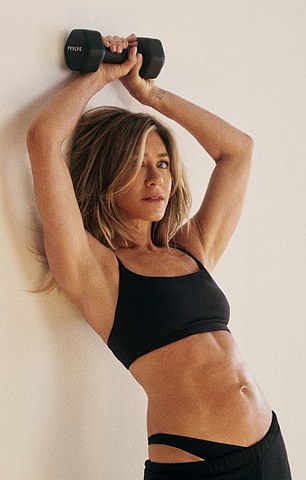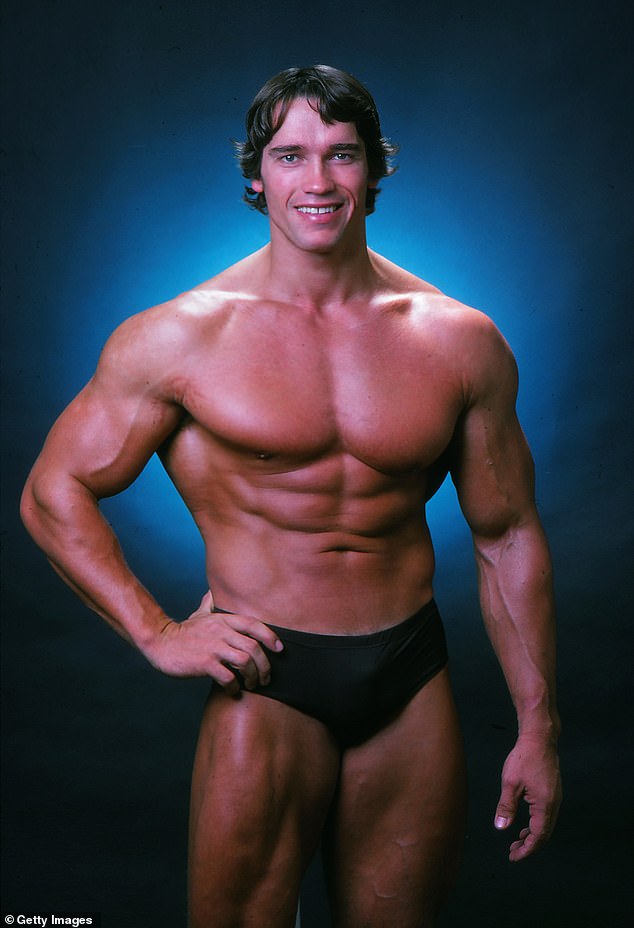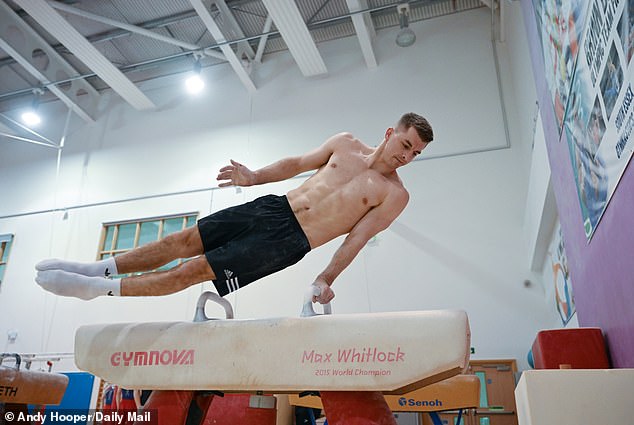It’s the holy grail of fitness – a toned midriff, the ultimate hallmark of an athletic, sculpted body.
Polls of gym-goers show that reducing tummy fat and achieving a flat stomach are among the most common reasons people exercise.
But for most of us, visible abs seem utterly unachievable – the preserve of Olympians, fitness influencers and Love Island contestants.
It is little surprise that researchers at the University of Alberta have found that the abdominals are one of the body’s main ‘problem spots’, where stubborn fat tends to gather. As American comedian Eric Andre once said, trying to get a six-pack is ‘a full-time job in itself.’
So why is getting ripped so difficult? Experts say there are three main reasons.
First, overall body fat must be extremely low for the abdominal muscles to show through.
Second, the abdominal muscles themselves need to be strong and well-developed – otherwise even a lean torso will look flat rather than defined.
And finally – perhaps least helpfully – most of what we’ve been told about building abs is wrong.


Jennifer Aniston, 56, maintains her trim size 2 figure through daily weight-training workouts and a strict diet

British sprinter Jess Ennis-Hill is famed for her impressive abdominal muscles – and winning the gold medal in the heptathlon at the 2012 London Olympics
But all is not lost. According to leading physiotherapists and personal trainers who spoke to the Daily Mail, anyone can achieve a six-pack – and in as little as three months – with the right approach.
Read on for the science-led guide to what you should (and shouldn’t) be doing if you want a perfectly chiselled stomach…
It’s not all genetics
First, the good news: everyone has a six-pack – the informal term for the long muscle that runs vertically up the abdomen, segmented by connective tissue that gives it its recognisable ‘packs’.
The trouble is, for most of us, it’s just covered by a pesky layer of subcutaneous fat. As a result, some people will find it easier to build visible abs than others, says London-based personal trainer Liz Marsland.
‘If you’re already quite lean – with not very much body fat – you can get abs in as little as three months,’ she says. ‘But the time frame will depend on your genetics or body type.’

American singer J Lo often posts her killer ab workout routine on her Instagram – with a typically session starting with a set of 50 hanging ab raises, 50 rope crunches, and 50 incline sit ups with a 45-pound plate

For most of us, visible abs seem utterly unachievable – the preserve of Olympians, fitness influencers and Love Island contestants (above)

Six-pack-sporting athletes Tom Daley and Noah Williams of Great Britain celebrate winning the silver medal in the Men’s Diving Synchronised 10m Platform Final Paris 2024 Olympic Games
Genetics can also determine the type of muscle you’re more likely to develop, she adds. ‘Some people have longer, leaner muscle fibres, known as type 1, which are used for endurance activities like long-distance running. Others, like sprinters, tend to have more powerful, visible muscles used for short bursts of energy.
‘Your genes decide which muscle type dominates – and type 2 fibres lend themselves to more visible ab muscles and a faster metabolism.’
Luckily, with the right training, these traits can be adapted. ‘It’s not that some people can and some can’t build abs,’ says Ms Marsland, ‘but rather how long it might take to get there.’
Abs aren’t built in the gym
Most people are put off by the idea of endless hours of gym training to achieve the perfect six-pack. But the secret to getting abs lies not in the gym – but in the kitchen, says personal trainer Ben Simpkins.
‘You can’t out-train a bad diet,’ he says. ‘You can do as much work as you want in the gym, but if you’re eating poorly or drinking regularly, you won’t see results.’
To make abs visible, body fat must be low enough – and the threshold differs for men and women.
Women, who naturally carry more fat, need a body fat percentage below 20 per cent to see definition, while men need around 10 to 15 per cent.

Arnold Schwarzenegger, now 78, said he changed his ab workout routine after losing his first bodybuilding competition soon after moving to the US. Up until that point, he later said, he hadn’t been targeting muscles like his internal obliques, transverse abdominis, or the serratus muscle under the side of the pecs
It’s worth noting that this level of leanness is relatively uncommon. Male professional athletes typically have between 6 and 13 per cent body fat, while very fit men tend to fall in the 14 to 17 per cent range. The average man usually sits between 18 and 24 per cent, with the upper end of this range classed as overweight.
Body fat can be measured using special scales that send a mild electrical current through the body, or the old-fashioned way – by taking a few key body measurements and using an online calculator (just search ‘body fat calculator’).
‘Unless you’re already super lean, most people will need to cut calories to reveal their abs,’ says Mr Simpkins.
Focus on high protein and fibre, and cut out unnecessary carbs, sugar and ultra-processed foods. Stay hydrated, he adds, and avoid needless calories from fizzy drinks and milky coffees.
Skip the crunches
Once your diet’s in check, it’s time to train the core itself – another area where many go wrong.
‘I think the biggest misconception is that crunches and sit-ups are the path to strong abs,’ says British Army veteran turned physiotherapist Nell Mead. ‘Traditional ab exercises focus on isolated muscle work in a single plane of motion – but your core doesn’t function in isolation.
‘It works as an integrated system to stabilise your entire body during real-world movements.’

Wolverine-star Hugh Jackman, 57, admitted to having a team of eight trainers, nutritionists and cooks who helped him get in shape for the film and said he ‘ate tilapia and beans for days’ to hone his physique
Instead, says Mr Simpkins, focus on exercises that target the deeper core muscles as well as the six-pack muscle – the rectus abdominis – which sits closer to the surface.
‘Don’t waste energy on endless crunches – include as many variations as possible that challenge the core in different ways,’ he explains.
At his studio, Mr Simpkins recommends strength training three times a week, combining weighted squats, kettlebell dips, planks and presses in each session.
‘You need the deeper muscles to be strong to stabilise your spine and protect you as you lift heavier weights – whether that’s in the gym or in day-to-day life,’ he adds. ‘To do this, focus on compound lifts that build strength – not 1,000 crunches a day.’
Train like a gymnast
Most gymnastic-style exercises – which use body weight to build muscle – are excellent for developing abs, says Ms Marsland.
‘Gymnasts have to keep every part of their body tight when performing routines – meaning their core is constantly engaged,’ she explains.
‘While movements performed sitting in gym machines are great for bodybuilders, whole-body exercises are far better for building abs – they engage more muscles and improve endurance.’

Gymnastic-style exercises – which use body weight to build muscle – are also brilliant for abs, says personal trainer Liz Marsland. Pictured here is British gymnast Max Whitlock, mid routine
For beginners, Ms Marsland suggests starting with a hollow hold: lying on your back, lift your shoulders and arms off the floor at the same time as your legs, forming a banana shape.
Hold for as long as possible, lower slowly, and repeat several times.
More advanced exercisers can try hanging leg raises from a pull-up bar – lifting the knees to the chest, then lowering slowly before repeating.
If that feels easy, try lifting your toes as high as possible while hanging from the bar.
‘These movements create the foundation for strong abdominal muscles,’ adds Ms Marsland. ‘Once you’ve built that base, core-specific exercises will be far more effective at developing defined, visible abs.’
Do core workouts before, not after, cardio
Another common mistake concerns when people choose to train their abs, says Mr Simpkins.
‘If you’re doing ab exercises after cardio or strength training, your form often slips because you’re tired,’ he explains.
‘People tend to leave crunches until the end of a workout because they seem easy – but that’s when they’re most likely to strain their neck or back instead of engaging their abs properly.’
Instead, train your abs first, focusing on controlled form rather than swinging your body through the motions.
‘Try different plank variations, such as bear planks and side planks, rather than the standard elbow hold,’ says Mr Simpkins.
‘These can be more effective than crunches for targeting the deeper abdominal muscles that wrap horizontally around your midsection.’
Downtime is just as important as gym time
One factor that plays a major role in where the body stores fat is hormones, says Ms Marsland.
High levels of cortisol – the stress hormone – have been linked to increased abdominal fat.
‘As well as exercise, I always tell clients to take a holistic approach,’ she says. ‘Spending 10-15 minutes a day doing something relaxing calms the nervous system and helps balance the body, which may in turn discourage fat storage.’
Research also suggests that the adaptogenic mushroom ashwagandha, available as a supplement, can help reduce cortisol and promote relaxation.
Ms Marsland advises taking ashwagandha with a magnesium supplement before bed.
‘Both have been shown to relax the nervous system, which can influence how – and where – the body stores fat,’ she says.
Don’t work too hard
While consistency in diet, sleep and exercise is key, overdoing it can backfire, warns Mr Simpkins.
‘People can go too hard too soon – or overload the muscles, making them sore or even injured,’ he says.
‘Push yourself enough, but don’t burn out. It’s better to make small, steady changes you can maintain than to go all in and give up a few weeks later.’
